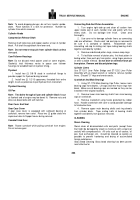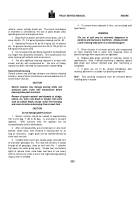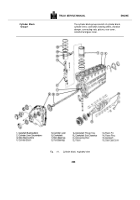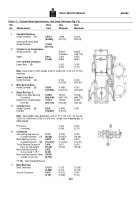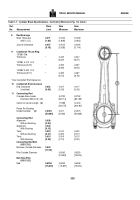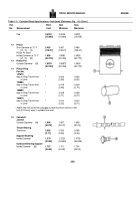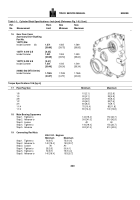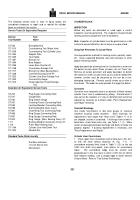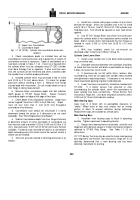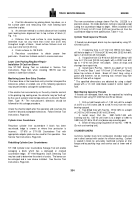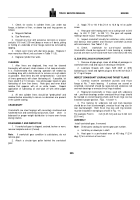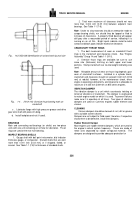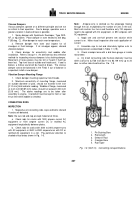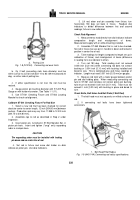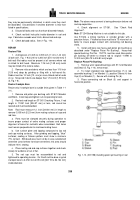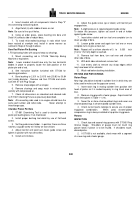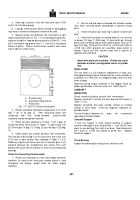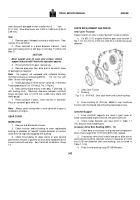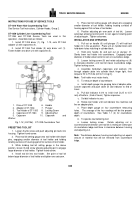TM-5-3805-254-14-P-2 - Page 338 of 894
TRUCK SERVICE MANUAL
ENGINE
a.
Find this dimension by placing block, top down, on a
flat surface plate and measuring from main bearing bore
centerline to plate.
b.
An alternate method is to check distance from installed
main bearing bore alignment bar to top surface of block (2,
Fig.
1-2).
c.
Distance from head surface to main bearing bore
centerline must not vary more than 0.002 inch [0.05 mm]
throughout length of block.
Head surface flatness must not
vary over 0.002 inch [0.05 mm].
4.
Finish surfaces to .125 R.M.S.
5.
Resurface
counterbore
to
obtain
proper
liner
protrusion.
Check liner to block contact in crevice seal area.
Lower Liner Packing Ring Bore Repair -
Installation Of Cast Iron Sleeve
Use ST-1081 Boring Tool as indicated in Service Tool
Instructions, Page 343, when installing 195778 cast iron
sleeves in lower bore of block.
Machining Lower Bore Entry Chamber
If the lower bore or the lower bore entry chamfer is beyond the
tolerances, pitted, or eroded, one of the following operations
may be performed to salvage the cylinder block.
If the erosion has occurred only on the entry chamfer and not
in the packing ring sealing area, the chamfer may be "built-up"
by the use of a plastic steel compound such as Devcon Plastic
Steel, Type "A." The manufacturer’s directions should be
followed for this salvage procedure.
Check the chamfer depth after this operation and resurface the
chamfer if beyond acceptable tolerances.
Follow Service Tool
Instructions, Page 343,
Cylinder Liner Counterbore
Resurface cylinder liner counterbore if block has been
resurfaced, ledge is uneven or where liner protrusion is
incorrect.
ST-676 or ST-1059 Counterbore Tool with
appropriate adapter plate can be used for this operation.
See
Service Tool Instructions, Page 343.
Rebuilding Cylinder Liner Counterbores
ST-1168 Cylinder Liner Counterbore Salvage Tool will enable
salvaging a block which has a damaged or cracked
counterbore ledge.
ST-1166 Magnetic Crack Detecting Tool
may be used to determine the extent of cracks.
The bores can
be enlarged and a new sleeve installed.
See Service Tool
Instructions, Page 343,
The new counterbore salvage sleeve Part No.
202226 is a
precision sleeve.
No inside diameter cutting is required except
cutting the counterbore ledge to depth.
When installed 0.005
inch [0.13 mm] to 0.010 inch [0.25 mm] must be cut from the
counterbore ledge to meet specification, Table 1-1 (2).
Cylinder Head Capscrew Threads
If threads are damaged, block may be repaired by using ST-
476 Heli-Coil Kit.
1.
If capscrew hole is 2-11/32 inch [59.53 mm] deep,*
drill hole to depth of 1-7/8 inch [47.63 mm] with 23/32 inch drill;
tap to 1-3/4 inch [44.45 mm] depth.
2.
If capscrew hole is 2-9/16 inch [65.09 mm] deep,* drill
hole to 2-1/16 inch [52.39 mm] depth with a 23/32 inch drill;
tap to 1-15/16 inch [49.21 mm] depth.
Clean all chips and
shavings from repair hole.
3.
Install insert, Part No.
102674, to a depth of 1/2 inch
[12.70 mm] for Step 1, and 11/16 inch [17.46 mm] for Step 2
below top surface of block.
Break off insert tang, using a
punch and hammer, not an inserting tool; remove tang from
bottom of hole with a magnet.
* The specified dimensions are obtained by using a depth
gauge with a 1/4 inch wide blade seated in center taper of’
hole.
Main Bearing Capscrew Threads
If threads are damaged, block may be repaired by installing
Heli-coil insert using ST-1230 Hell-Coil Kit as follows:
1.
Drill out old threads with a 1-1/32 inch drill to a depth
of 2.675 to 2.705 inches [68.16 to 68.74 mm] from the main
bearing cap pad.
2.
Tap drilled hole with Tap No.
9193-16H4 to a depth
of 2.425 to 2.455 inches [61.60 to 62.36 mm].
3.
Install insert, Part No.
3591-16CN-1.500 with
inserting tool No.
535-16 until insert is to a depth of 0.860 to
0.890 inch [21.84 to 22.61 mm] below cap mounting pad.
4.
Break off tang using tang break-off tool No.
1196-16.
(Do not use inserting tool.)
CYLINDER LINERS
Cummins cylinder liners form combustion chamber walls and
are in direct contact with coolant for efficient cooling.
Coolant
is sealed in block by accurately machined surfaces at liner
flange and by packing rings and crevice seal at lower end of
liner.
334
Back to Top

